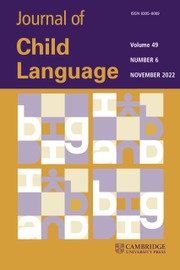Crossref Citations
This article has been cited by the following publications. This list is generated based on data provided by
Crossref.
Berman, Ruth A.
1983.
Establishing a schema: Children's construals of verb-tense marking.
Language Sciences,
Vol. 5,
Issue. 1,
p.
61.
Berman, Ruth A.
1984.
ON THE STUDY OF FIRST LANGUAGE ACQUISITION.
Language Learning,
Vol. 33,
Issue. s5,
p.
221.
Rom, Anita
1985.
VERB USAGE BY EDUCABLE MENTALLY RETARDED CHILDREN.
Journal of Intellectual Disability Research,
Vol. 29,
Issue. 2,
p.
165.
Ingram, David
1985.
The psychological reality of children's grammars and its relation to grammatical theory.
Lingua,
Vol. 66,
Issue. 1,
p.
79.
Borer, Hagit
and
Wexler, Kenneth
1987.
Parameter Setting.
Vol. 4,
Issue. ,
p.
123.
Clark, Eve V.
and
Berman, Ruth A.
1987.
Types of linguistic knowledge: interpreting and producing compound nouns.
Journal of Child Language,
Vol. 14,
Issue. 3,
p.
547.
Landsmann, Liliana Tolchinsky
and
Levin, Iris
1987.
Writing in four- to six-year-olds: representation of semantic and phonetic similarities and differences.
Journal of Child Language,
Vol. 14,
Issue. 1,
p.
127.
Kail, Michèle
and
Charvillat, Agnès
1988.
Local and topological processing in sentence comprehension by French and Spanish children.
Journal of Child Language,
Vol. 15,
Issue. 3,
p.
637.
Sokolov, Jeffrey L.
1988.
Cue validity in Hebrew sentence comprehension.
Journal of Child Language,
Vol. 15,
Issue. 1,
p.
129.
Rom, Anita
and
Leonard, Laurence B.
1990.
Interpreting deficits in grammatical morphology in specifically language-impaired children: Preliminary evidence from Hebrew.
Clinical Linguistics & Phonetics,
Vol. 4,
Issue. 2,
p.
93.
Braine, Martin D. S.
Brody, Ruth E.
Fisch, Shalom M.
Weisberger, Mara J.
and
Blum, Monica
1990.
Can children use a verb without exposure to its argument structure?.
Journal of Child Language,
Vol. 17,
Issue. 2,
p.
313.
Gropen, Jess
Pinker, Steven
Hollander, Michelle
and
Goldberg, Richard
1991.
Affectedness and direct objects: The role of lexical semantics in the acquisition of verb argument structure.
Cognition,
Vol. 41,
Issue. 1-3,
p.
153.
Berman, Ruth A.
1993.
Marking of verb transitivity by Hebrew-speaking children.
Journal of Child Language,
Vol. 20,
Issue. 3,
p.
641.
Leonard, Laurence B.
and
Dromi, Esther
1994.
The use of Hebrew verb morphology by children with specific language impairment and children developing language normally.
First Language,
Vol. 14,
Issue. 42-43,
p.
283.
Levy, Yonata
1996.
Morphology and syntax in the language of children with congenital brain pathologies a longitudinal follow up.
Journal of Reproductive and Infant Psychology,
Vol. 14,
Issue. 3,
p.
255.
Tolchinsky Landsmann, Liliana
and
Levin, Iris
1996.
L’entrée dans l’écrit.
p.
47.
Levy, Yonata
1997.
The development of morphology and syntax in a pair of DZ twin boys.
International Journal of Language & Communication Disorders,
Vol. 32,
Issue. 2,
p.
206.
Shimron, Joseph
1999.
The role of vowel signs in Hebrew: Beyond word recognition.
Reading and Writing,
Vol. 11,
Issue. 4,
p.
301.
Barrière, I.
Lorch, M.
and
Le Normand, M. T.
2000.
New Directions In Language Development And Disorders.
p.
139.
B. Leonard, Laurence
Dromi, Esther
Adam, Galit
and
Zadunaisky‐Ehrlich, Sara
2000.
Tense and finiteness in the speech of children with specific language impairment acquiring Hebrew.
International Journal of Language & Communication Disorders,
Vol. 35,
Issue. 3,
p.
319.

